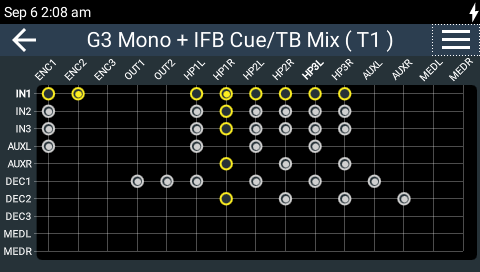
The codec supports both cue and talkback functions. Cue provides:
•Offline communications between local announcers via the headphone jack outputs when the TB CUE button is pressed on inputs 1-3.
•Offline monitoring of the auxiliary input via headphone output 1 (HP1 only by default).
Talkback communication is available on inputs 1-3 between the remote codec and the studio. This requires a dedicated IFB connection when using a:
•Mono Peer-to-Peer + IFB program, or
•Stereo Peer-to-Peer + IFB program.
It is also possible to broadcast mono program and use a separate communications channel, with either the Tieline Music or Music PLUS algorithm, over a stereo program using the G3 Mono Peer-to-Peer + IFB program template.
Configuring Cue and Talkback Matrix Routing
There is a separate Cue/TB matrix for each headphone output and for each program type, e.g. mono, stereo, Mono + IFB, Stereo + IFB. To view these matrices open the Matrix Editor by selecting HOME ![]() > Audio
> Audio  > Matrix Editor
> Matrix Editor  . Inputs are listed on the left and outputs are displayed at the top of the matrix.
. Inputs are listed on the left and outputs are displayed at the top of the matrix.
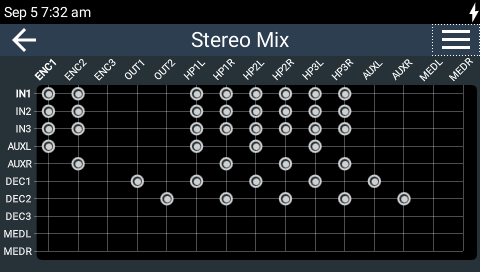
There are three ways to view the Cue/TB Mix screen from the Matrix Editor screen:
1.To momentarily view Cue/TB Mix routing, briefly press the TB CUE button on inputs 1-3, or the CUE button on the stereo auxiliary input.
2.To view the Cue/TB Mix screen and edit routing press and hold the TB CUE button on inputs 1-3, or the CUE button on the stereo auxiliary input for 3 seconds. Note: it is possible to overlay more than one Cue/TB Mix on the screen simultaneously. The TB CUE button is illuminated if a mix is active. Cue and talkback audio is also audible.
3.View and edit the Cue/TB Mix screen via Menu  > Cue/TB Edit > Cue 1-3/Aux > Edit
> Cue/TB Edit > Cue 1-3/Aux > Edit  .
.
Cue and talkback crosspoint routing is overlaid in the matrix and indicated in yellow. In the following default stereo cue matrix example, when the TB CUE button for input 1 is pressed, audio from input one is audible locally in the right side of headphones 1-3. In other words, the Cue/TB Mix overrides Matrix Editor audio routing while the button is pressed.
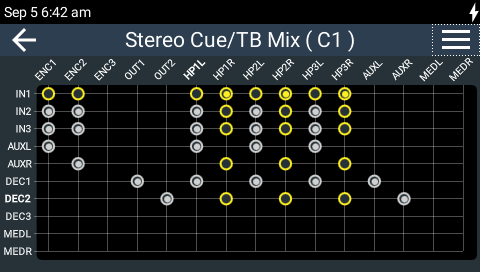
Editing Cue and Talkback Routing
To edit the routing of cue and talkback audio, either:
1.Tap a crosspoint on the TOUCH SCREEN to select or deselect an audio crosspoint, or
2.Use the NAVIGATION buttons to focus on a crosspoint and press the OK button to select or deselect an audio crosspoint.
In the following example, audio routing edits have been applied to select encoder 2 (ENC2) and the left side of headphones 1-3. Note: Changes not yet saved as a custom mix are displayed in orange. Runtime changes are audible in real-time and persist if the unit is powered down and rebooted.
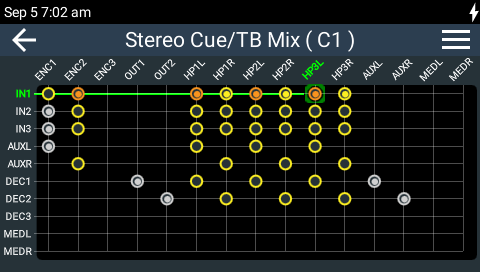
Edits to the Cue/TB Mix for each headphone output can be saved as a Custom Mix with all the other routing displayed in the Matrix Editor. To save all routing edits:
1.Tap Menu  and then Save as.
and then Save as.
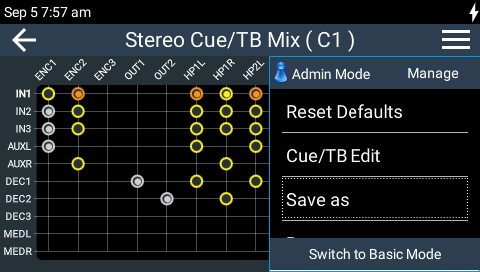
2.Enter a new Mix Name and tap Done in the top right-hand corner of the TOUCH SCREEN.
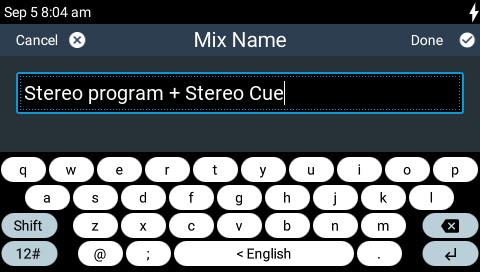
Understanding Cue Mode
Typically, local cue intercom is configured for commentators to talk to each other offline. In cue mode, offline communications audio from inputs 1-3 is routed to the right side of all local headphone outputs (HP 1-3) when the TB CUE button is pressed. By default this is the same for:
•Mono Peer-to-Peer programs.
•Stereo Peer-to-Peer programs.
•2 x Mono Peer-to-Peer programs.
In the following matrix routing example, the CUE TB button for input 1 has been pressed and a mono program is loaded in the codec. Cue audio is audible in the right side of HP 1-3.
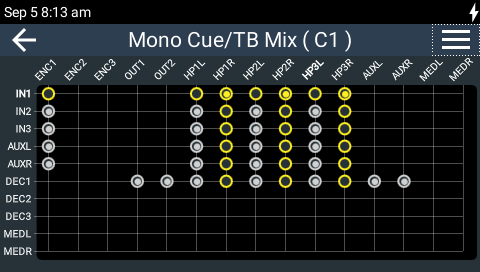
Auxiliary Input Cue
The codec supports offline cueing of external analog and digital sources attached to the stereo auxiliary input. By default, offline cue monitoring of the auxiliary input is only available via headphone output 1 (HP1). This routing can be adjusted as required.
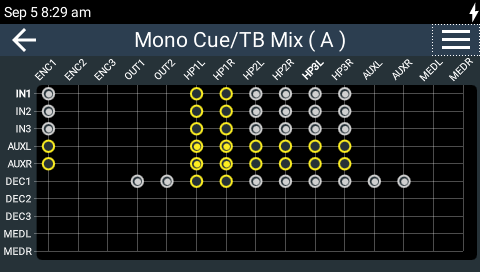
Mono Program Aux Cue Defaults
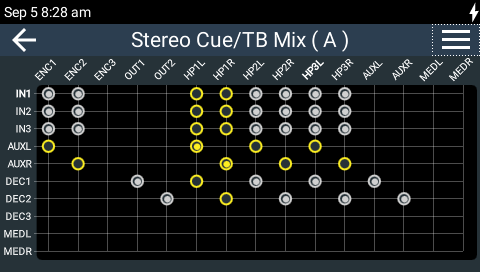
Stereo Program Aux Cue Defaults
Understanding Talkback Mode
When you load a Mono Peer-to-Peer + IFB program, or a Stereo Peer-to-Peer + IFB program, two independent audio streams are configured to stream program and communications audio separately. When an announcer presses an input's TB CUE button, audio is routed to the IFB audio stream encoder and outgoing audio is simultaneously monitored in the right side of the selected input's headphone output. Return IFB audio is also audible in the right side of the headphones. In other words, only the announcer using the CUE TB button hears incoming and outgoing communications audio.
In the following matrix routing example a Mono Peer-to-Peer + IFB program is loaded in the codec. When the CUE TB button for input 1 is pressed, outgoing talkback audio is sent to encoder 2 (ENC2) and it is monitored in the right side of HP 1. Return IFB from the studio is also audible in the right side of HP 1.
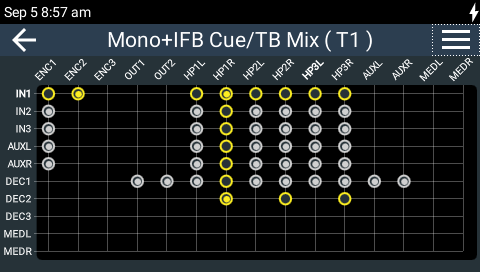
Default Mono + IFB TB Routing
In the next matrix routing example a Stereo Peer-to-Peer + IFB program is loaded in the codec. When the CUE TB button for input 1 is pressed, outgoing talkback audio is sent to encoder 3 (ENC3) and it is monitored in the right side of HP 1. Return IFB from the studio is also audible in the right side of HP 1.
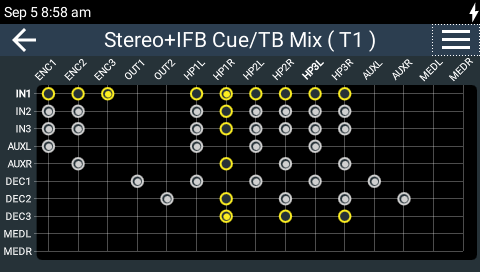
Default Stereo + IFB TB Routing
Using G3 Mono Peer-to-Peer + IFB Mode with a Stereo Connection in ViA
It is also possible to connect a stereo program and use one channel for talkback communications. This is preconfigured in ViA if you create a program using the G3 Mono Peer-to-Peer + IFB program template.
|
Important Note: This program template will only work if you are using Tieline Music or Music PLUS algorithms. |
The following image displays the talkback routing matrix defaults for a G3 Mono Peer-to-Peer + IFB program. When the CUE TB button is pressed on inputs 1-3 the codec will deliver discreet talkback between local announcers and a remote codec using encoder 2 (ENC2). Incoming IFB audio is monitored in the right channel of the headphones by default.
